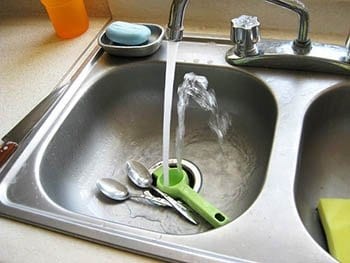
 Whether it’s mid-afternoon or the middle of the night, there’s no plumbing problem quite as ominous as a drain that stops draining water down into your pipes and instead starts sending it back up.
Whether it’s mid-afternoon or the middle of the night, there’s no plumbing problem quite as ominous as a drain that stops draining water down into your pipes and instead starts sending it back up.
Today we’ll take a quick look at the different types of drains this problem can occur in and what you can do to help keep the damage it can cause to a minimum.
Common, Usually Minor: Kitchen Sink
Drain clogs in kitchen sinks are one of our most common calls. Kitchen sinks tend to end up the repository of all kinds of food waste — the crumbs that didn’t get finished at dinner, the lemon and lime peels after you’ve used the juice for a favorite recipe, grease or oil that’s solidified as it cooled in your drains… even if you have a garbage disposal, clogs can build up over time.
A sink that drains slowly is a red flag; a sink that’s stopped draining entirely or is starting to back up is in need of serious assistance. You have a couple of options here:
- Grab a plunger. Fill the sink partway with water and use the plunger as directed. This should help to move a more minor clog along and free up the space in your drain.
- Use a drain snake (or auger), which are widely available wherever plungers are sold. You may be able to break up the clog manually.
- If neither of these options work, we recommend calling in a professional. They can take a look and remove the clog by physically getting into your drains and finding out where it is and what can be done.
- Whatever you do, do not use chemical drain cleaners. They are ineffective at best, and can cause injuries to plumbers or service technicians who work on your still-clogged drain afterwards.
Next in Line: Bathroom Sink Or Shower/Tub Drain
For the bathroom sink or sinks, you can really follow the same steps for the kitchen sink. Bathroom sinks tend to clog up with bits of toothpaste rather than food particles, so those clogs are often easier to undo. Shower and bathtub drains, however, can be a little more difficult.
The clogs tend to involve hair, which can be very difficult to remove. Luckily, it is very rare for these clogs to be sudden and you will usually see slow draining for weeks before you reach a critical stage. Here are a few steps you can take to help fix things up:
- You can try the same plunging trick we used for the kitchen sink. Be sure to unscrew the drain cover first. For very small issues, this may clear things up.
- Larger clogs may require snaking. Unscrew the drain cover and use your drain snake to fish out whatever caused the clog.
- If it seems like there isn’t any real clog in the drain, the cover itself may be to blame. Soap scum can build up, slowing the draining after a bath or shower even without a physical problem in the drain itself. Unscrewing (or using a lever to pop up, in the case of shower drains that have no screws) and cleaning the drain cover with a mix of hot water and vinegar should take care of this problem.
- After the clog is cleared, be sure to run very hot or boiling water down the drain for at least thirty seconds. This should help make sure things stay clear.
- As always, call a professional if these steps don’t help or fix the issue.
Rare, But Serious: Basement Drains
We may not receive these calls as often, but they are sometimes the most damaging issues. After a lot of rain, a serious thunderstorm, or clogs that back up far into the drain itself, you may find water or even sewage coming back up your basement drain. Laundry rooms or mudrooms (really anywhere that has a floor-based drain system) can also fall prey to similar issues.
Are you the DIY type? If so, we have one trick that may work for you:
- Rent an electric auger. For serious floor drain clogs that you’re looking to take care of on your own, this will be the most effective option. You’ll need to remove the drain cover and clean-out plug first, so you can bypass the trap and go directly into the pipe. Some drains don’t have a clean-out plug and so you’ll have to snake directly through the trap, which will be a little more difficult. Plug in the auger, position it in the drain, and begin working it into the pipe. Set the motor for a clockwise rotation and slowly work your way through in a back-and-forth motion until you’ve cleared the clog.
- For basement or floor drains in general, we don’t usually recommend a DIY approach. Clogs can be very serious, and when you have water backing up into your basement it’s best to get a certified professional on-site as fast as possible.
Need Help? We’re Here For You.
When you’ve exhausted these DIY options and the clog still won’t budge, Donnelly’s Plumbing Heating and Cooling is ready to help! We’re happy to send out our service professionals, day or night, to make sure your drains are clean, clear, and safe for your household. Give us a call at [hls_phone_number] or schedule service online at any time!